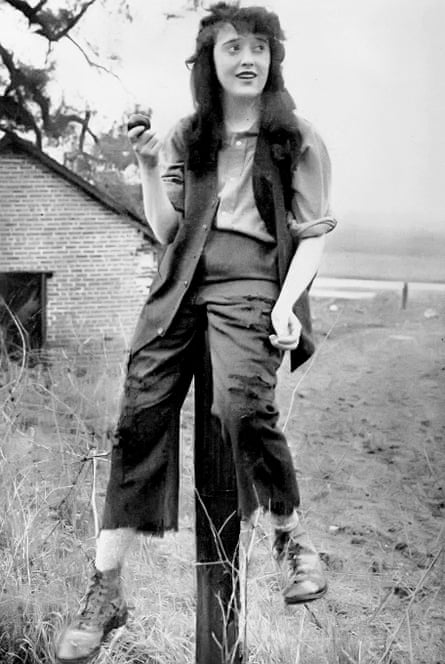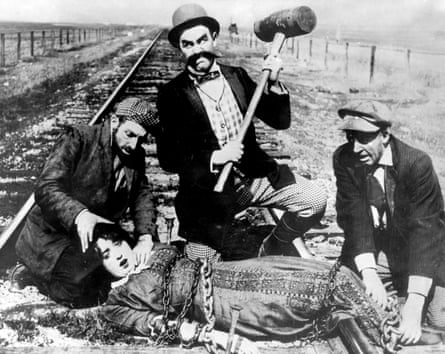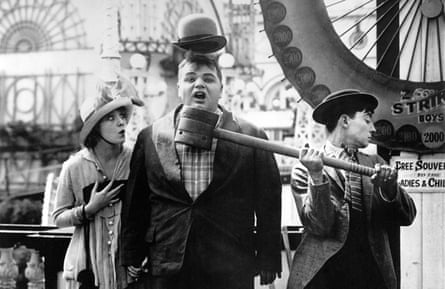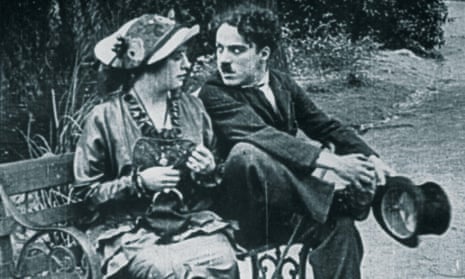She was, said Julian Johnson, a lyrical critic at Photoplay, “a kiss that explodes in a laugh; cherry bon-bons in a clown’s cap; sharing a cream puff from your best girl; a slap from a perfumed hand”. At the height of her career, this tomboy daredevil with screen-idol looks was Hollywood’s queen of comedy. At its nadir, a pariah.
Today, Mabel Normand is largely unknown, but a forthcoming BFI season looks set to refocus the spotlight on the woman who changed cinema for ever through pies, pratfalls – and her protege, Charlie Chaplin.

Her story began conventionally enough. Born in New York in 1892, at 14 Normand became an artist’s model, posing for Charles Dana Gibson’s series of pen-and-ink drawings of idealised femininity that became known as “Gibson Girls” . A move on to the big screen was the logical next step; she was the young woman ashamed to introduce her shabbily clad mother to her suitor in DW Griffith’s Her Awakening (1911).
It was a touching performance, which brought her to the attention of Mack Sennett, a director then best known for his Bathing Beauties, a bevy of babes in swimwear, who popped up in Sennett’s comedies time and time again. The two began a relationship and relocated to California in 1912, when he founded Keystone Pictures Studio. In Normand, Sennett spotted what he sensed the big screen needed: untrammelled, untrained potential.
To him, her lack of a formal theatrical background was a massive asset. Ingenues at the time had a tendency to big-eyed stiffness and the weight of their stage legacy was substantial. Normand, by contrast, had an on-screen looseness that still feels strikingly modern. She was also funny and inventive, and was given the freedom to indulge both. She had, she later explained, “no precedent, nothing to imitate … I had to cleave a new path to laughter”.
In Tomboy Bessie (1912), Normand became (arguably) the first star to use the screen aside as a comic device, breaking the fourth wall to confide in the audience – a technique that became her trademark. The following year, she had the bright, and then novel, idea of spicing up a scene by chucking a custard pie. “A million laughs hung on her aim as the custard wobbled in a true curve and splashed with a dull explosion,” said Sennett. The target was hit, the impact enormous, and the lobbing of baked goods became a Keystone speciality. Ballistic-filled tarts were developed for the perfect “splurch”.
This immersive approach to gloop was indicative of Normand’s attitude to all things, especially stunts. Her rambunctious willingness to hurl herself about became the hallmark of her slapstick screen persona, Madcap Mabel.“There was no cliff so high that Mabel was afraid of it,” as Mary Pickford put it; “no bucking bronco too wild for her to ride; as for dodging Keystone pies, there was no one ever on the screen who could do it more gracefully and with as much poise as Mabel.”

Normand not only played the damsel in distress (in Barney Oldfield’s Race for a Life, she was the first gal to be tied to the railroad tracks), she also flipped a stereotype only a few years in the forging, by frequently rescuing the leading man instead. “It was new to see women doing this,” says Ally Acker, Author of Reel Women: The First Hundred Years. “Pearl White also did her own stunts, but no one else was spoofing the serials and turning them into comedy.”
Films such as Mabel’s Dramatic Career and Mabel’s New Hero made her one of the first actors to have their own name in the title; she also directed many of them, too. Such multitasking was unusual, but, in the lawless land of early cinema, says Acker, “all kinds of people could and did move easily between roles … there were no rules.”
Then, in September 1913, Keystone signed a new star. Vaudevillian Charlie Chaplin was 24 and out of his depth. “He couldn’t understand what was going on,” said Sennet, “why everything went so fast, and why scenes were shot out of chronology.” Normand, four years his junior but already the veteran of more than 100 films, became his mentor. She directed many of his movies, beginning with Mabel’s Strange Predicament (1914), in which Chaplin’s Tramp made his screen debut, and starred in others. Writer Jon Boorstin credits Normand’s relaxed pace – which allowed Chaplin to “eat up film” – as crucial in giving the Tramp’s persona space to emerge. Though Chaplin later claimed he had “no idea of the character” until donning his costume, Normand recalled evenings spent together planning “little mannerisms” such as “the queer shuffling little walk of an old costermonger he once saw in Whitechapel”. Others have gone further. Film historian Raymond Lee says Chaplin owes Normand his “greatest debt”. “A study of her films, made before Chaplin came to this country, shows entire routines, gestures, reactions, expressions, that were later a part of Chaplin’s characteristics.”
The hits kept coming, but Chaplin jumped ship to a rival studio a year later for $1,250 (£965) a week; Normand remained at Keystone for a paltry $175, where Fatty Arbuckle became her new leading man. After a brief split from Sennett in 1916, the pair reconciled and founded the Mabel Normand Feature Film Company, making her one of the first women to have her name above a studio. It made just one film – Mickey – but it was a winner: the highest grossing picture of 1918, which Normand considered her best work.

This precipitous rise to the top was mirrored in the manner of her decline. She moved to Goldwyn, but began to suffer frequent bouts of illness. Then Arbuckle was accused of the rape and murder of co-star Virginia Rappe, and, the following year, Normand became embroiled in the yet-unsolved murder of director William Desmond Taylor.
Sensationalist newspaper stories hinted she was a dope fiend and that Desmond was killed by her dealer; on New Year’s Day 1924, her chauffeur shot a Denver oil baron called Courtland Dines with Normand’s gun. The films Arbuckle and Normand had shot were pulled from distribution. The former was acquitted after a third trial but his career never recovered.

With the support of Sennett and Pickford, Normand gradually came back into pictures, making a string of films at Hal Roach Studios, but found herself increasingly usurped. “The day of the rough and tumble and slapstick seems to have passed,” she said, before dying of TB in 1930, aged 37. Chaplin and Griffiths were pallbearers, along with Louis B Mayer, Samuel Goldwyn and Douglas Fairbanks.
“If I am lucky, I hope again to make the world laugh as I once did,” she said before she died. The BFI season offers an opportunity for her to do so, as well as a chance for us to learn from this most trailblazing patisserie queen.

Comments (…)
Sign in or create your Guardian account to join the discussion